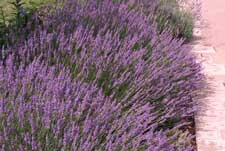Resource Library
Plant of the Week: Lavender, English
The University of Arkansas System Division of Agriculture does not promote, support or recommend plants featured in "Plant of the Week." Please consult your local Extension office for plants suitable for your region.
Plant of the Week
English Lavender
Latin: Lavandula angustifolia

Herbs are steeped in tradition and lore unparalleled by other garden plants. Of the herbs, English lavender (Lavandula angustifolia) probably has about it more mystique than all the rest. Though it is a storied plant that is hardy in much of the country it’s not commonly seen.
English lavender belongs to the aromatic mint family. It’s not native to England but to the mountainous regions north of the Mediterranean. It’s called English lavender because it’s one of the few lavenders able to grow out of doors in English gardens.
English lavender is a mound growing semi-evergreen semi-woody subshrub reaching 18 inches tall and 2 feet across. Older branches eventually turn woody while new shoots are herbaceous. The gray to green leaves are two inches long, slender in outline and highly aromatic.
When in flower in early summer, it sends slender spikes of lavender-blue flowers 8 to 12 inches above the canopy of the plant. The flowers cluster at the ends of the spike and are individually small, two-lipped affairs contained in a tubular, purple-grey calyx about half as long as the flowers. It’s the oil glands on the calyx where most of the lavender oil is produced. While blue is the most common, pink and white flowered selections are available.
Lavender has long been a part of the herbal scene and is gaining new advocates as “aromatherapy” increases in popularity. Lavender oil is commercially extracted from this species and L. x intermedia, the French lavender. Oils are used as an ingredient for scenting everything from perfumes to shampoos and soaps. About 60 pounds of flowers are needed to produce one pound of lavender oil. Dried lavender flowers are widely used in sachets and potpourris.
In the past couple years, a medical controversy has arisen concerning the use of lavender oil in scenting over the counter products, especially shampoos. Preliminary research, based on
Petri dish studies, suggests lavender oil mimics the activity of estrogen and inhibits the activity of androgens, the male hormone. A group of 5- to 8-year-old boys with enlarged breasts were all found to all be using a shampoo scented with lavender oil. When they were switched to a different shampoo their condition returned to normal.
In addition to its place in the herb garden, lavender can be grown in the average home landscape provide careful attention to site selection and maintenance is provided. Crowding it into a bed with other perennials will usually result in failure. ‘Hidcote’ is a dwarf selection and considered one of the easiest to grow.
Lavender is hardy from zones 5 to 8. It grows best in sunny, south facing areas with sandy or gravely soil with a slightly alkaline pH. Unlike many perennials, subshrubs such as lavender and santolina should be grown in lean, relatively dry soils. Wet soils, especially during wintertime, cause root rot and are responsible for most plant losses.
High summer humidity is not to its liking so planting amongst rocks, near a south facing stone walls or near expanses of hot concrete sidewalks may actually help. Also, when mulching, use stone mulch, not bark. Because of its preference for hot and relatively dry location lavender is an ideal choice for inclusion in xeroscape plantings and rock gardens.
About every third year, prune lavender bushes back in early spring to 8-inch stubs. This will keep the top of the plant young and vigorous and encourage compact growth. Light summertime pruning after flowering will encourage reblooming.
By: Gerald Klingaman, retired
Extension Horticulturist - Ornamentals
Extension News - July 20, 2007
The University of Arkansas System Division of Agriculture does not maintain lists of retail outlets where these plants can be purchased. Please check your local nursery or other retail outlets to ask about the availability of these plants for your growing area.